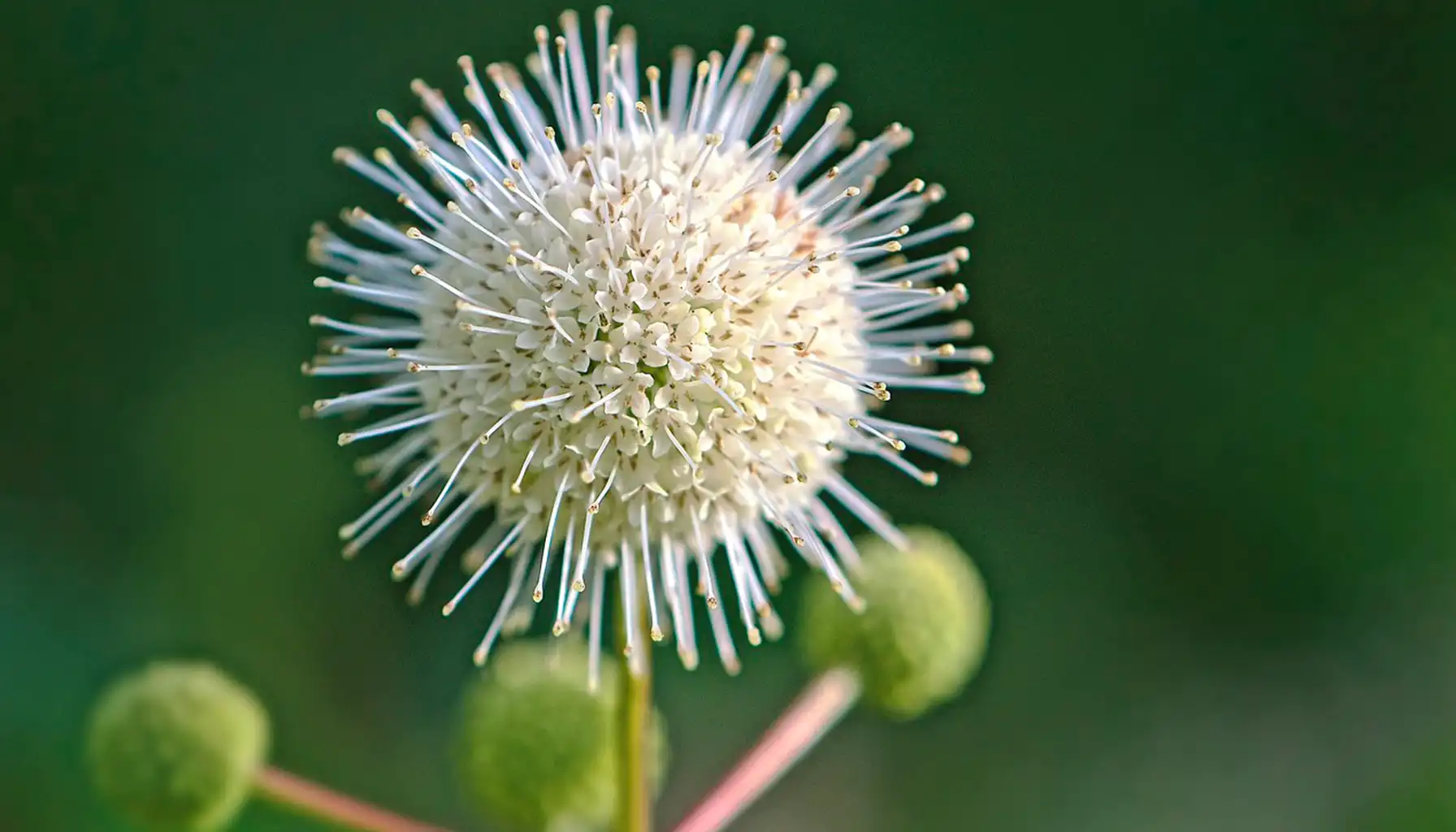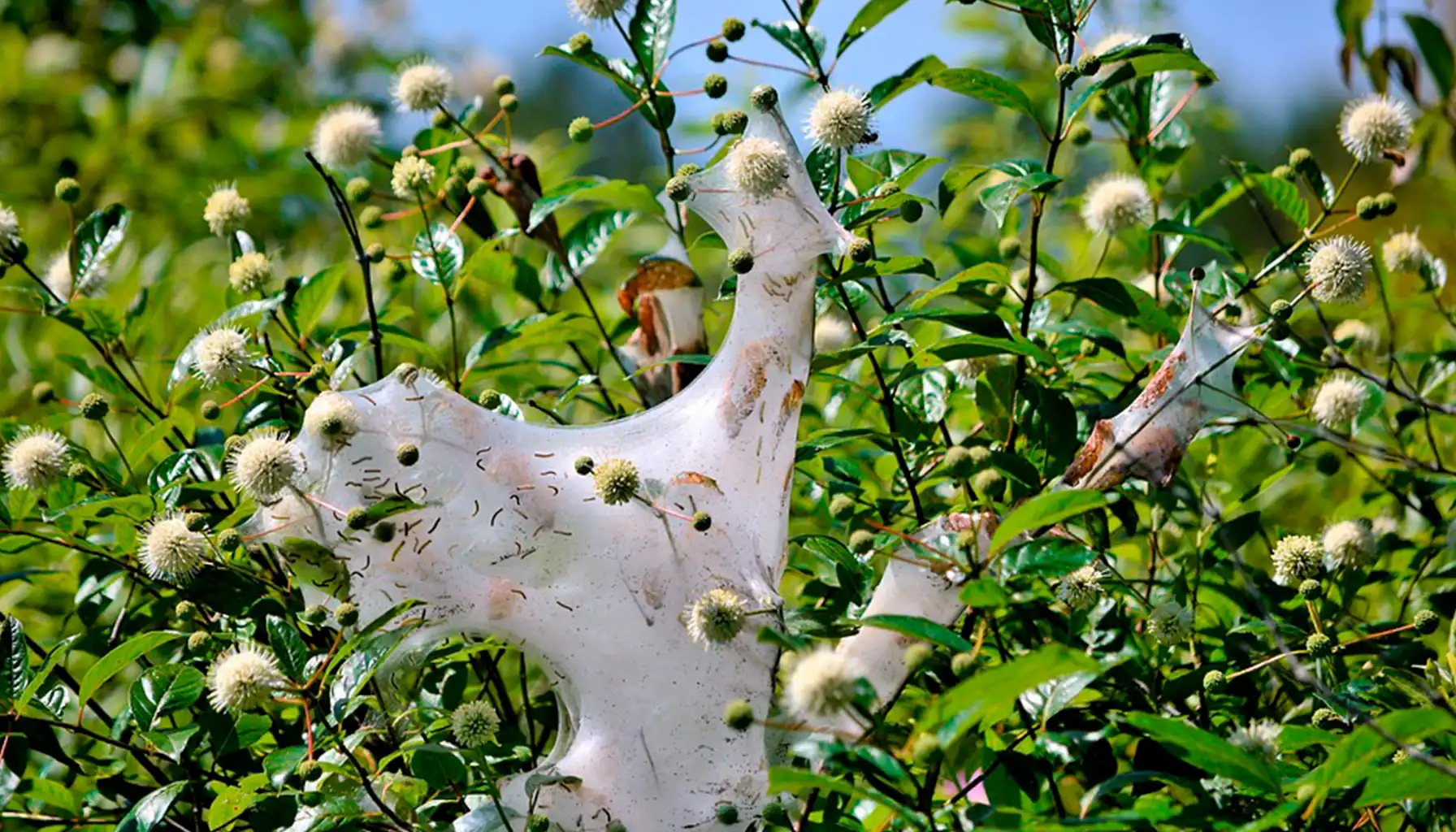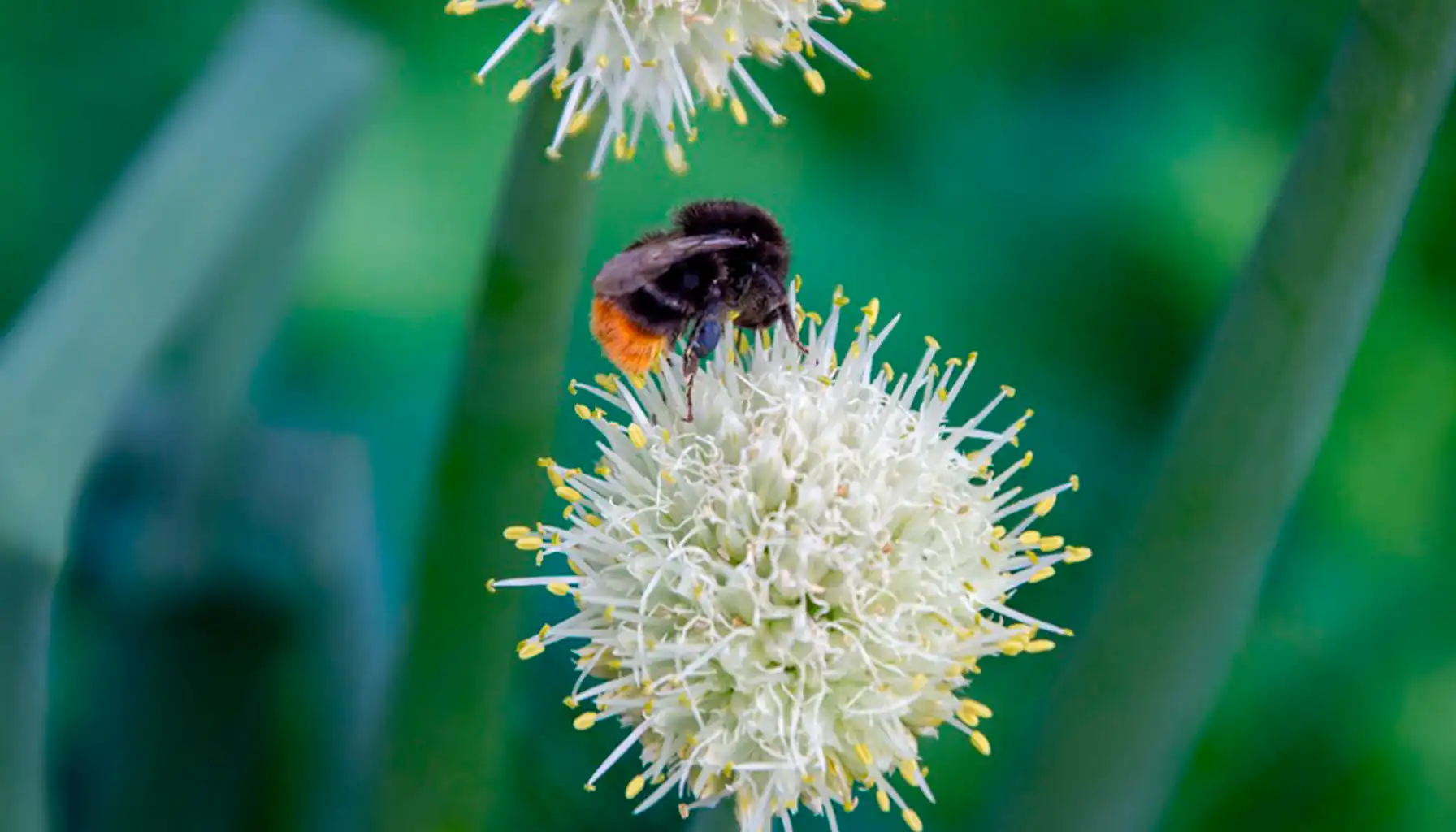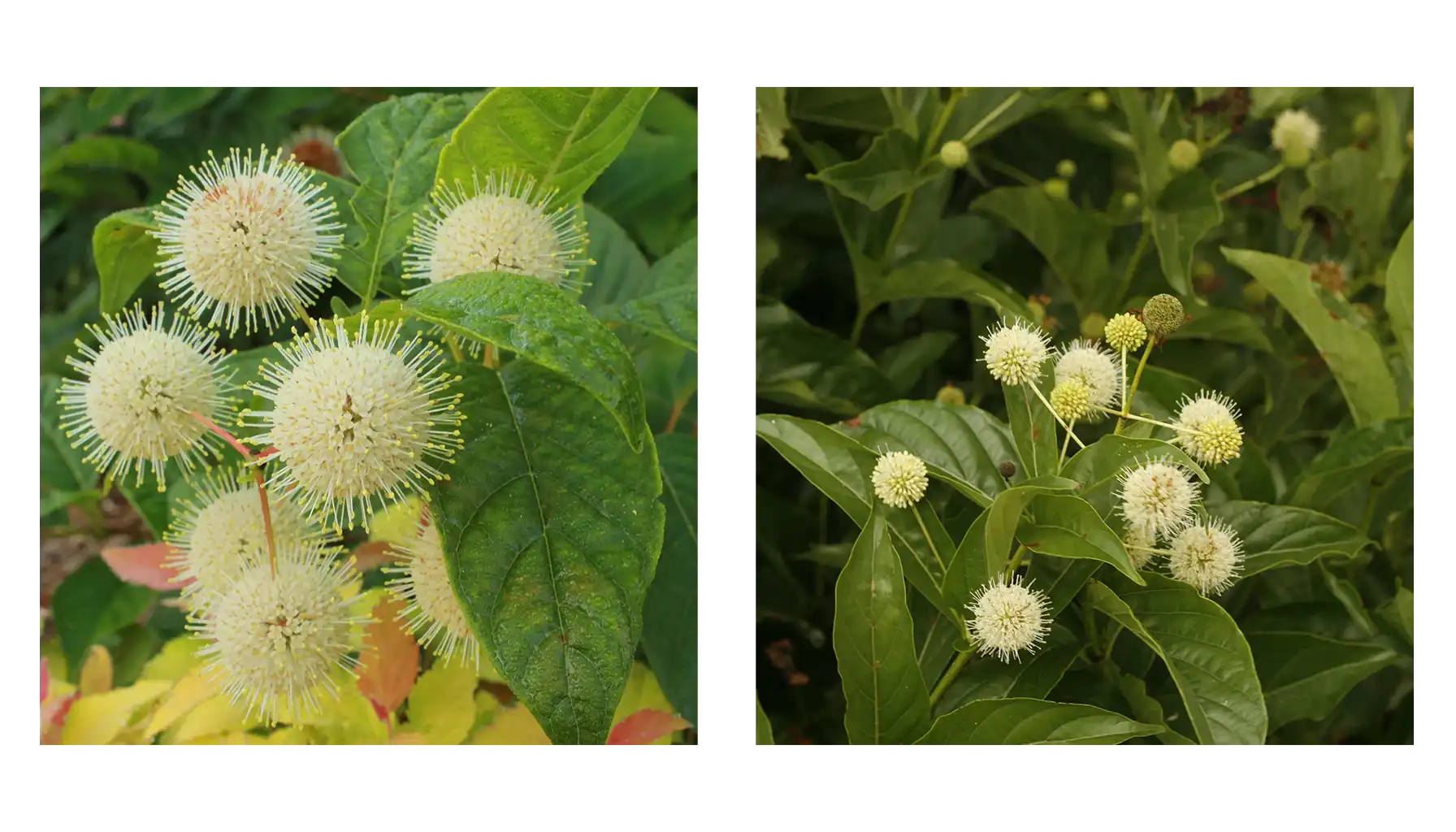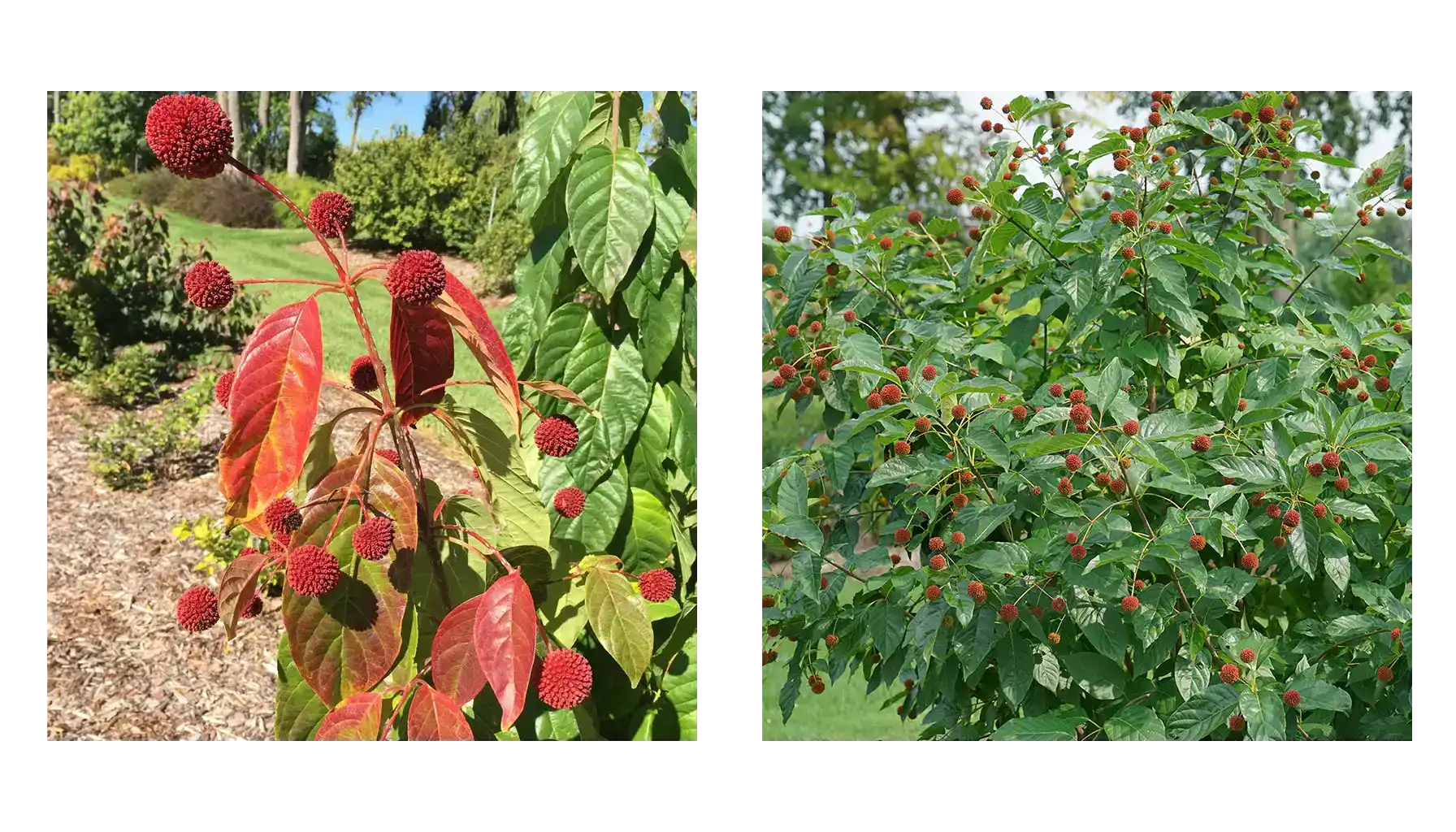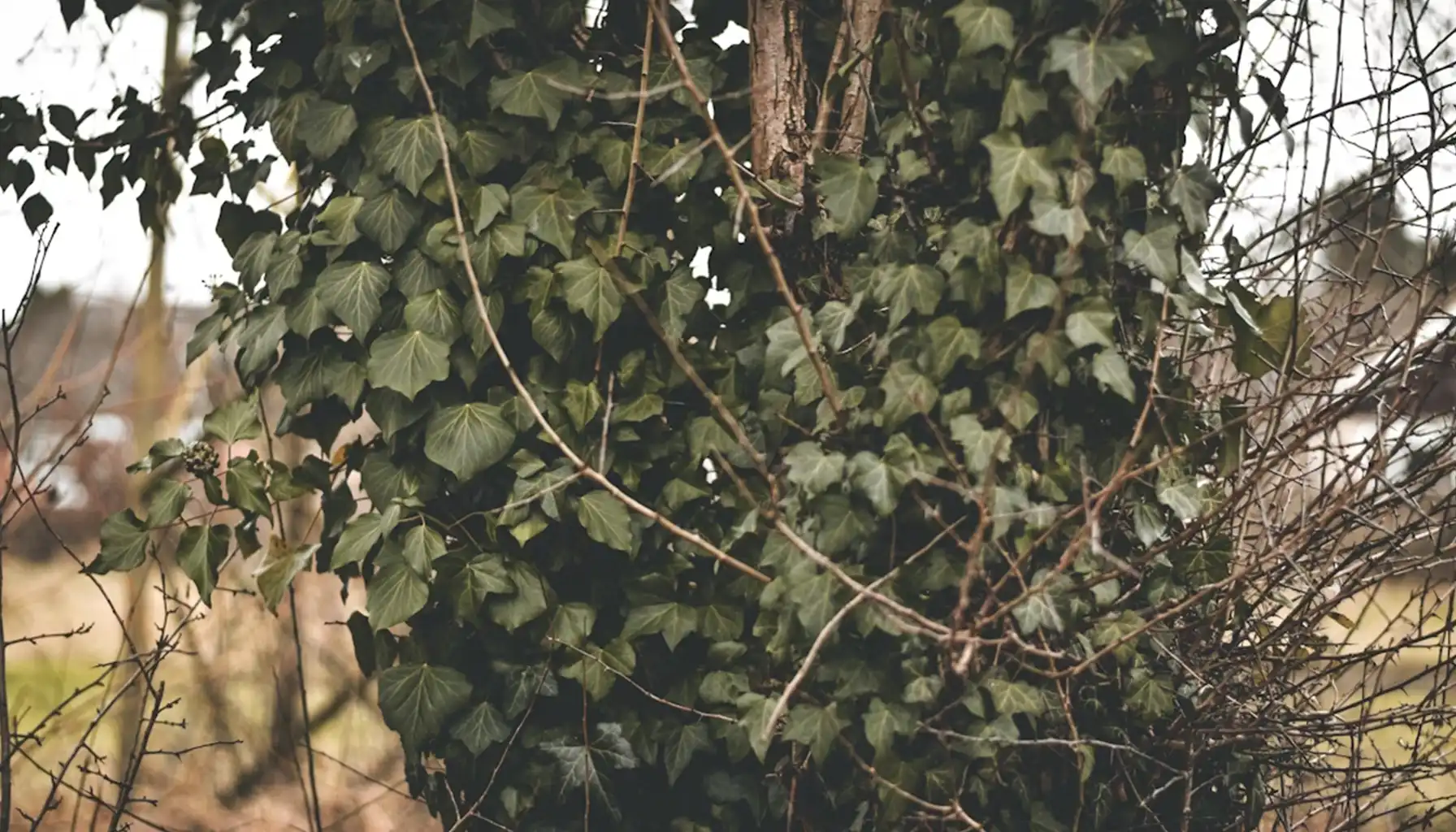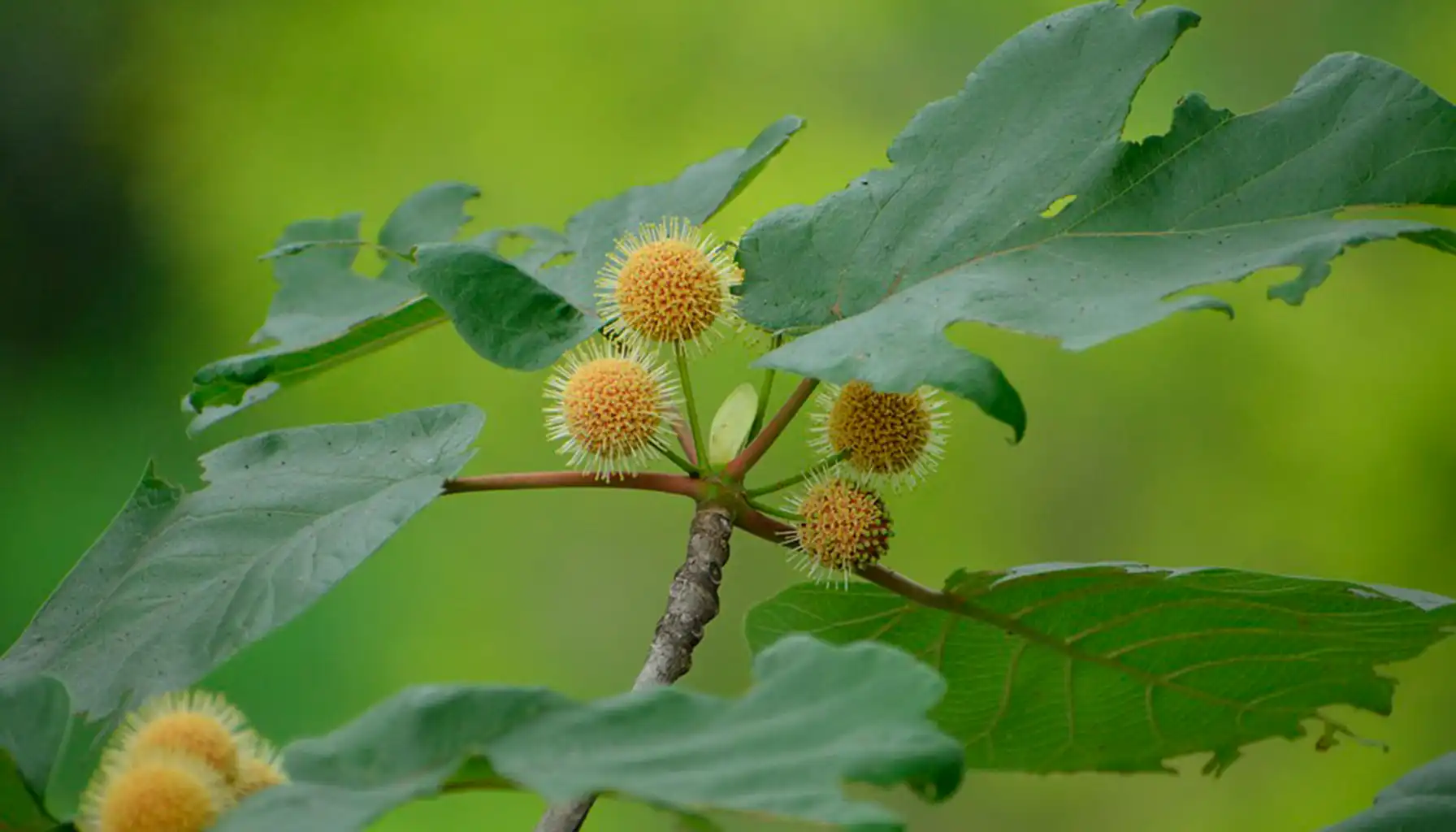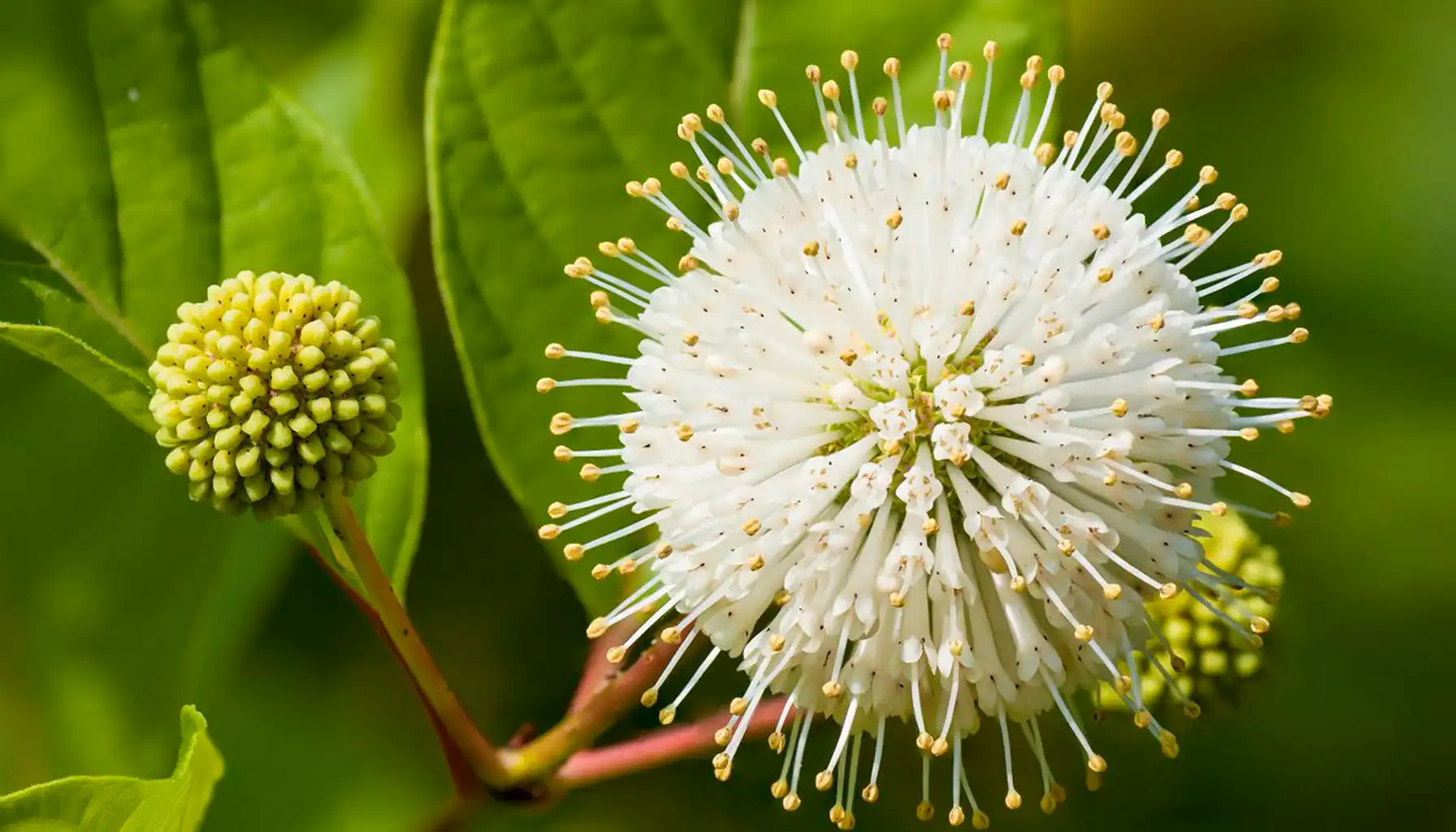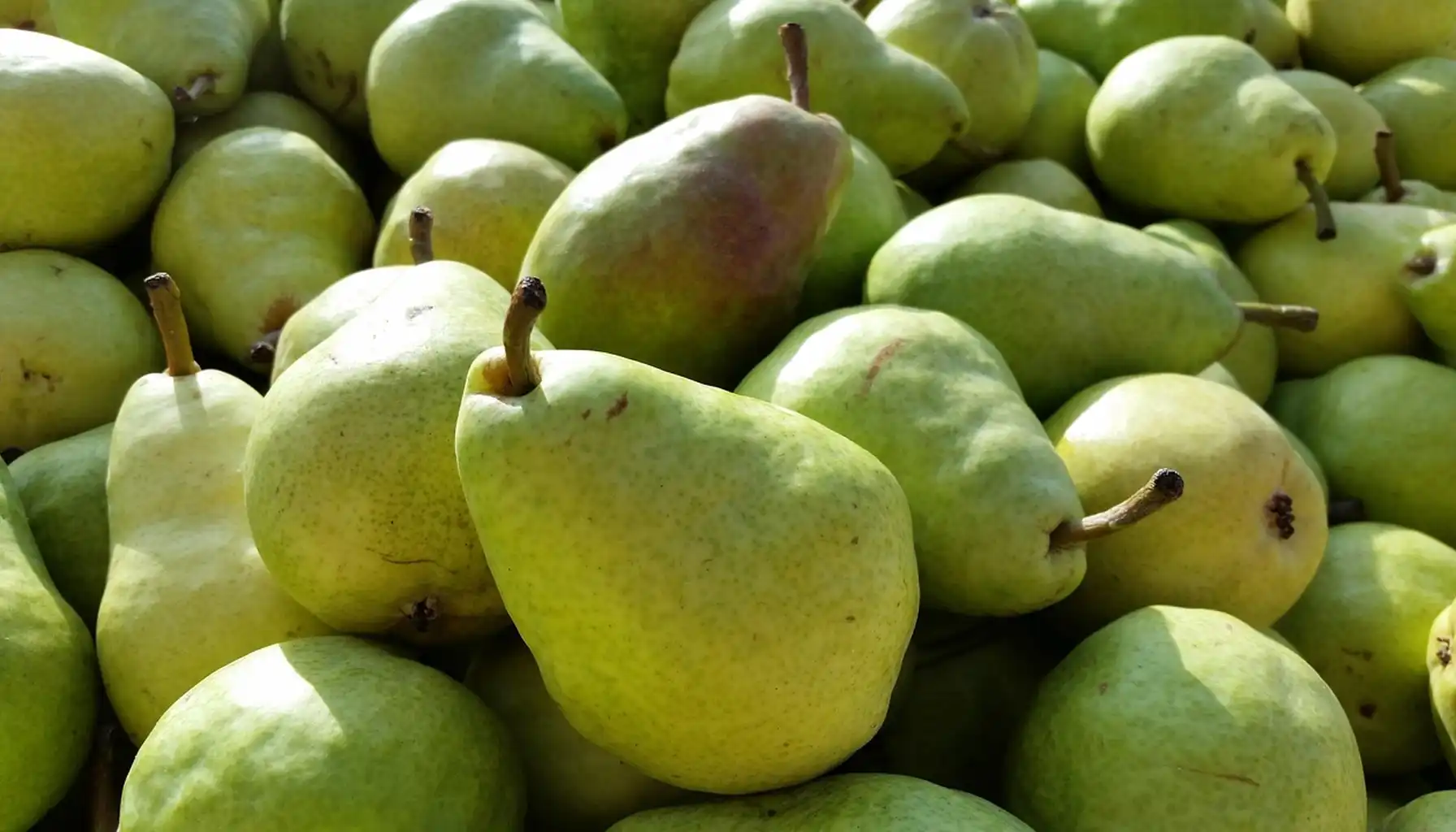The buttonbush shrub immediately catches the eye. In summer, it's covered in globular white flowers—it's as if someone had hung tiny pincushions in the garden. It remains attractive in fall and winter: the fruit stays on the branches, and birds happily feed on them.
Native to North America, it’s often found near rivers, in swamps, and along lakesides. But it has long since expanded beyond the wild: it’s becoming more common in gardens and parks, especially where a hint of wild charm is welcome.
And to avoid racking your brain trying to figure out what kind of plant it is, digital assistants are always a great help. For example, a free plant identifier—take a photo, and you know the name of the bush and how to care for it.
General Description of the Buttonbush Shrub
Buttonbush (Cephalanthus occidentalis) belongs to the Rubiaceae family. You’ll find it in wetlands, on river floodplains, and near lakes, where the soil stays damp and the sun is strong.
Morphological Features and Buttonbush Size
The shrub grows 1.5 to 3.5 meters tall, sometimes growing into a small tree.
The crown is spreading and rounded, often with multiple trunks.
The leaves are large, glossy, opposite or in groups of three, up to 20 cm long.
The flowers are small, white or cream-colored, gathered in spherical inflorescences up to 3 cm in diameter.
Its size makes it versatile—it can be used as a compact shrub by a pond or as a striking accent in landscape design.
Historical and Cultural Background of Common Buttonbush
Distribution and Buttonbush Native Range
This shrub is no rarity: it's found throughout almost all of eastern and southern North America, as well as in Canada, Cuba, and even Central America. Wherever there's a swamp, a slow stream, or still water, you're almost certain to spot a buttonbush. It tolerates flooding well, which is why it's so valuable in wetland restoration programs.
Interestingly, indigenous peoples used the bark and leaves as medicine. However, today we know that this shrub is poisonous to livestock, making it unsuitable for grazing. Colonists, however, discovered other uses: they valued it as a fine honey plant and grew it in gardens to freshen damp spots.
Buttonbush Tree vs. Shrub
Growth Form and Buttonbush Height
Sometimes buttonbush develops as a bush, but under favorable conditions it can reach 6 m, turning into a tree.
Table: Growth form comparison
Form | Average Height | Crown Width | Features |
Shrub | 1.5–3 m | 2–3 m | Perennial shoots, compact form |
Tree | 4–6 m | 3–4 m | Small tree with curved branches |
Seasonal Beauty: Buttonbush Fall and Winter
Buttonbush Fall
In autumn, the plant seems to change rhythm: the leaves turn a soft golden color, not flashy but calm, as if the plant is preparing for winter. You won't see the bright colors of a maple, but you don't need them—all the beauty is in the fruit.
They are gathered into dense balls that hang in clusters and attract attention far more than the foliage. Against the backdrop of a fading garden, these balls look especially impressive.
Buttonbush in Winter
When winter arrives, the shrub retains its decorative appeal. These brown fruits stay on the branches and turn into a favorite snack for ducks and water birds.
Against a snowy backdrop, the shrub looks graphic and even slightly sculptural. The button-like fruits on dark branches stand out sharply, giving the garden unexpected energy even during frosty calm.
Winter care is simple and requires no extra effort:
No covering is necessary—the shrub tolerates frost well without extra protection.
Mulch at the roots helps maintain a stable soil temperature and protects the rhizome from sudden changes.
Watering is avoided: even during a thaw, it's best to leave the roots alone; excess moisture in cold weather is harmful.
Pruning is postponed until spring—it's easier to remove dead or damaged branches when the shrub begins to actively awaken.
Buttonbush in Landscape
Buttonbush Hedge and Garden Uses
An ideal choice for moist areas that usually resist planting. It is used:
To stabilize banks and prevent erosion.
In garden compositions near ponds.
As a buttonbush hedge along streams.
To attract bees, butterflies, and birds.
It is often combined with moisture-loving plants, such as Kaleidoscope Abelia, which adds bright accents.
Buttonbush Varieties and Cultivars
Sugar Shack Buttonbush
A dwarf variety,growing only 1–1.2 m tall. Ideal for small gardens and container growing. People appreciate it for being both compact and for keeping its lively fruit well into winter.
Magical Moonlight Buttonbush
It features light foliage with a silvery sheen. The flowers appear in abundant clusters, and the bush looks especially elegant in the evening when the moonlight plays on the leaves.
Crimson Comet Buttonbush
Distinguished by its reddish shoots and richly colored fruits, this variety is well-suited for contrast in mixed borders.
Fiber Optics Buttonbush
An interesting variety. Its inflorescences are especially dense and bright white, reminiscent of a bundle of optical fibers. Thanks to this look, the shrub easily becomes the garden’s main highlight.
Buttonbush Care and Growing Conditions
Buttonbush Growing Conditions
This shrub has its quirks, but if you get it just right, it will grow without a hitch:
Soil. It prefers moist soil, especially clay or loamy soil. If the area is damp and puddles linger after rain, this isn’t a problem for the shrub but actually a benefit. The main thing is that the soil doesn't turn to stone during drought.
Light. In full shade, it struggles and blooms poorly. But give it a little sun—at least in the morning or afternoon—and the shrub immediately revives, gaining strength and producing more flower balls.
Moisture. The hotter the summer, the more it craves water. And if you plant it near water—a pond, stream, or swamp—you can forget about a watering can altogether: the roots will cope on their own.
Temperature. It tolerates both cold winters and hot summers. Its range extends from USDA zones 4–9, so it thrives equally well in temperate climates and in places with harsher winters. It only requires access to moisture and at least half a day of sunlight.
The bush grows moderately quickly, adding 30–60 cm per year. This moderate buttonbush growth rate allows for a fairly quick decorative effect in the garden.
Buttonbush Plant Problems
Buttonbush Problems in Practice
Although the plant is hardy, it does have its weaknesses:
It blooms poorly in the shade.
Drought causes leaf drop.
Root rot is possible in heavy soils.
Serious diseases are rare, and pests generally avoid the shrub.
Gardeners also value the shrub because it is buttonbush deer resistant. Deer rarely damage the leaves due to their bitter taste.
Buttonbush Benefits for Wildlife and Humans
Why Grow Buttonbush
This plant does a lot of good:
It sets out nectar that draws in bees and butterflies.
Its seeds turn into food for ducks and other birds.
Its roots quietly hold the riverbanks together, keeping them safe from erosion.
And all year round, it adds ornamental beauty.
In the wild, Air Plant can coexist with it, creating an exotic mix of moisture-loving species.
Buttonbush Scientific and Practical Aspects
Buttonbush Scientific Name and Taxonomy
The official buttonbush scientific name Cephalanthus occidentalis. The Latin epithet "occidentalis" means "western," as opposed to its Asian relatives.
Cephalanthus occidentalis buttonbush is ideally adapted to swamps and floodplains. Floods don’t ruin it — it stays attractive and keeps bringing benefits to nature.
Buttonbush Propagation and Seeds
Buttonbush Seeds
Propagation is possible by division or from seed. The seeds ripen in autumn and can be kept all winter. For good germination, they usually need a period of cold stratification.
Miniature forms, such as dwarf buttonbush, make it suitable for growing even in small gardens or urban courtyards. That’s what makes this plant a favorite — anyone can grow it.
Buttonbush Plant Availability
Buttonbush for Sale
Today, nurseries around the world offer them. The standard variety and several popular dwarf cultivars are most commonly available. When purchasing, it's important to check the plant's age, container or bare root, and the USDA zone for your area.
In winter gardens, this shrub is sometimes paired with exotic species, such as Norfolk Island Pine, creating a contrast between tropical and North American styles.
Buttonbush in Gardens and Future Prospects
Buttonbush in Landscape Architecture
The shrub is often planted in gardens, parks, and even city landscapes. It stands up to floods with no trouble, which is why it’s often picked for rain gardens and biofilters.
When fully grown, a buttonbush often becomes the focal point of the garden: spherical flowers in summer, decorative fruits in autumn, and a graceful crown in winter.
AI Plant Finder App
AI Plant Finder helps you recognize plants and care for them. Just snap a photo — the app will tell you what plant it is, share care tips, and even warn you about possible diseases.
Main features:
Plant Identification by Photo — plant recognition based on a photo.
Diagnosis by Photo — disease detection and treatment recommendations.
Expert Care Tips — care tips.
Extensive Database — over 300,000 plant species.
AI Botanist — virtual consultant.
My Garden Tool — watering, fertilizing, and pruning reminders.
Water Calculator — calculates precise watering volumes.
Light Meter — measures light intensity.
The app is available for free on iOS and Android.
Related AI Plant Finder Posts
